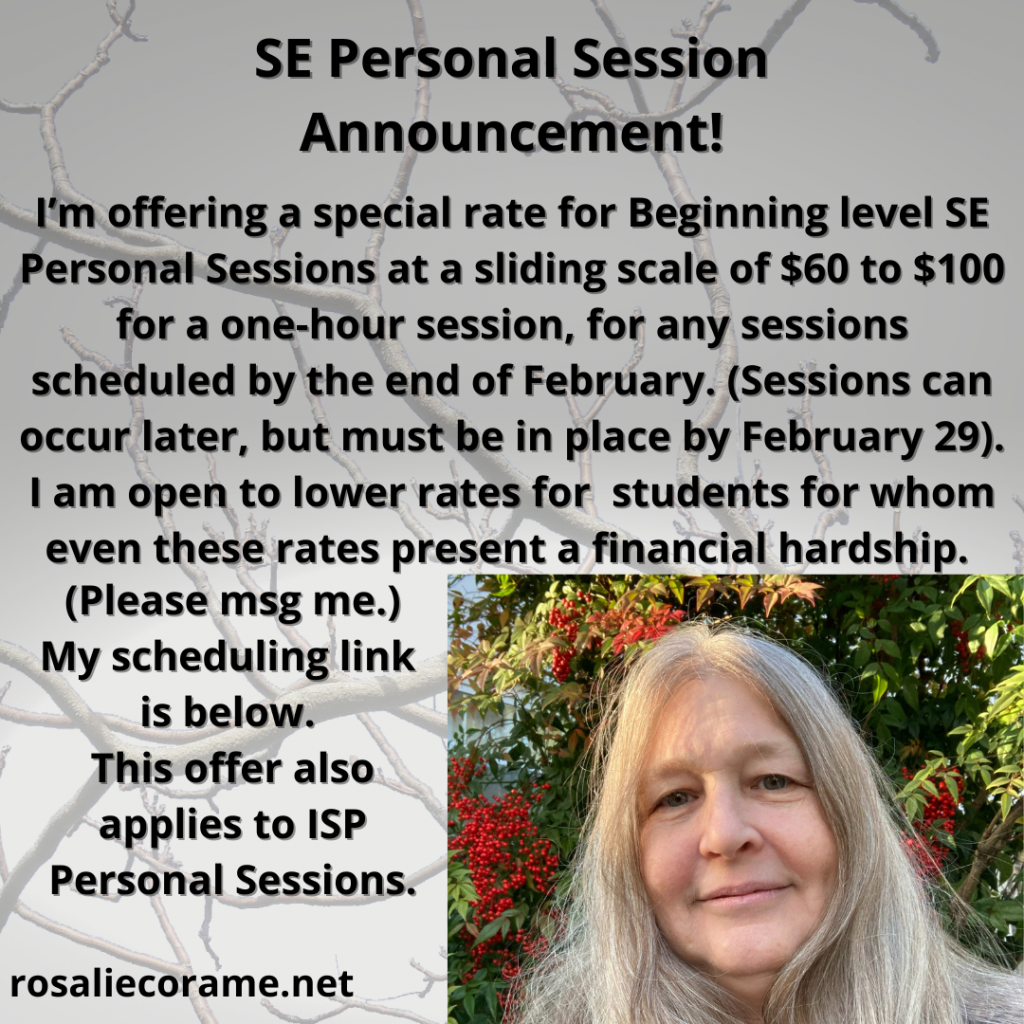
SE Personal Session Announcement


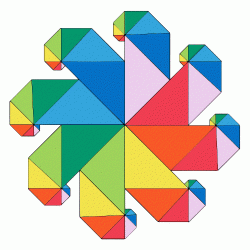
Somatic Developmental Trauma Healing with Rosalie Corame
Coaching for Somatic Healing and Personal Growth

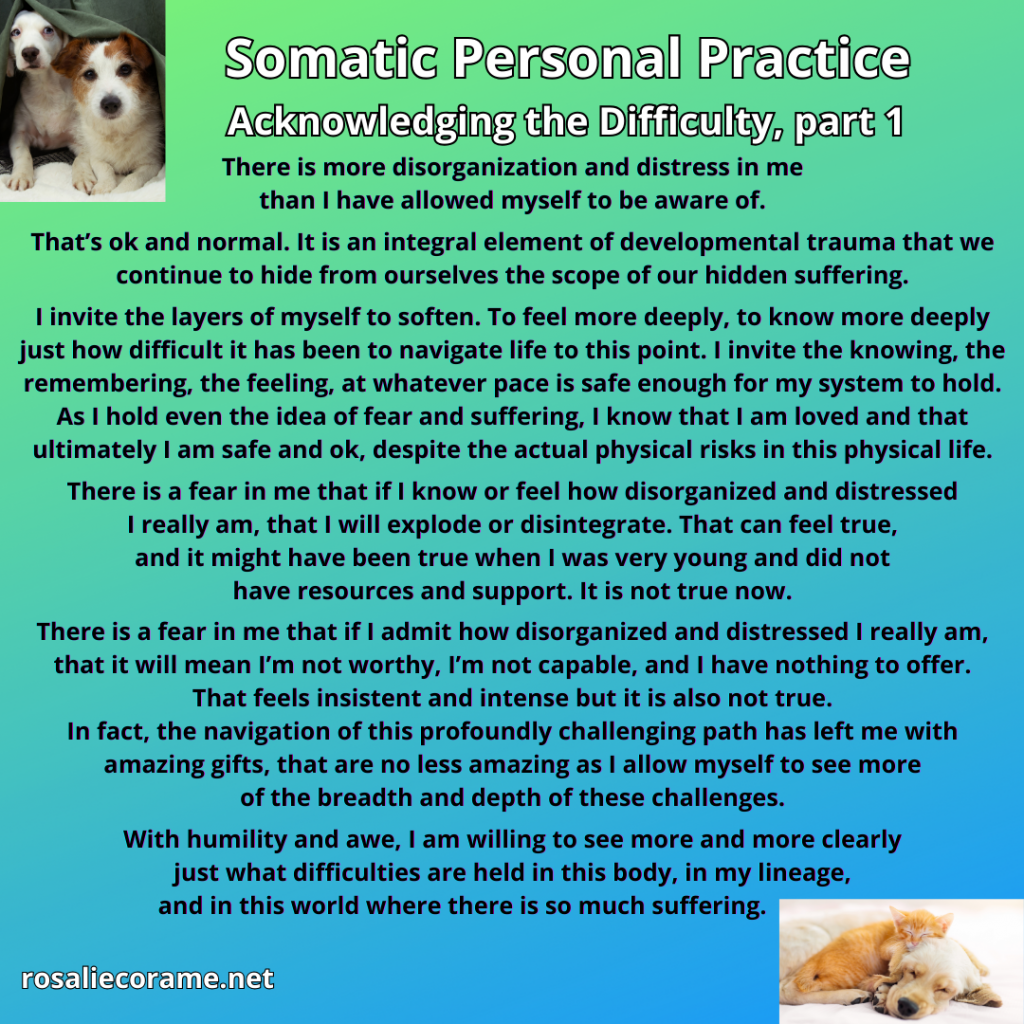
Acknowledging the Difficulty, part 1
There is more disorganization and distress in me than I have allowed myself to be aware of.
That’s ok and normal. It is an integral element of developmental trauma that we continue to hide from ourselves the scope of our hidden suffering.
I invite the layers of myself to soften. To feel more deeply, to know more deeply just how difficult it has been to navigate life to this point. I invite the knowing, the remembering, the feeling, at whatever pace is safe enough for my system to hold. As I hold even the idea of fear and suffering, I know that I am loved and that ultimately I am safe and ok, despite the actual physical risks in this physical life.
There is a fear in me that if I know or feel how disorganized and distressed I really am, that I will explode or disintegrate. That can feel true, and it might have been true when I was very young and did not have resources and support. It is not true now.
There is a fear in me that if I admit how disorganized and distressed I really am, that it will mean I’m not worthy, I’m not capable, and I have nothing to offer.
That feels insistent and intense but it is also not true.
In fact, the navigation of this profoundly challenging path has left me with amazing gifts, that are no less amazing as I allow myself to see more of the breadth and depth of these challenges.
With humility and awe, I am willing to see more and more clearly just what difficulties are held in this body, in my lineage, and in this world where there is so much suffering.
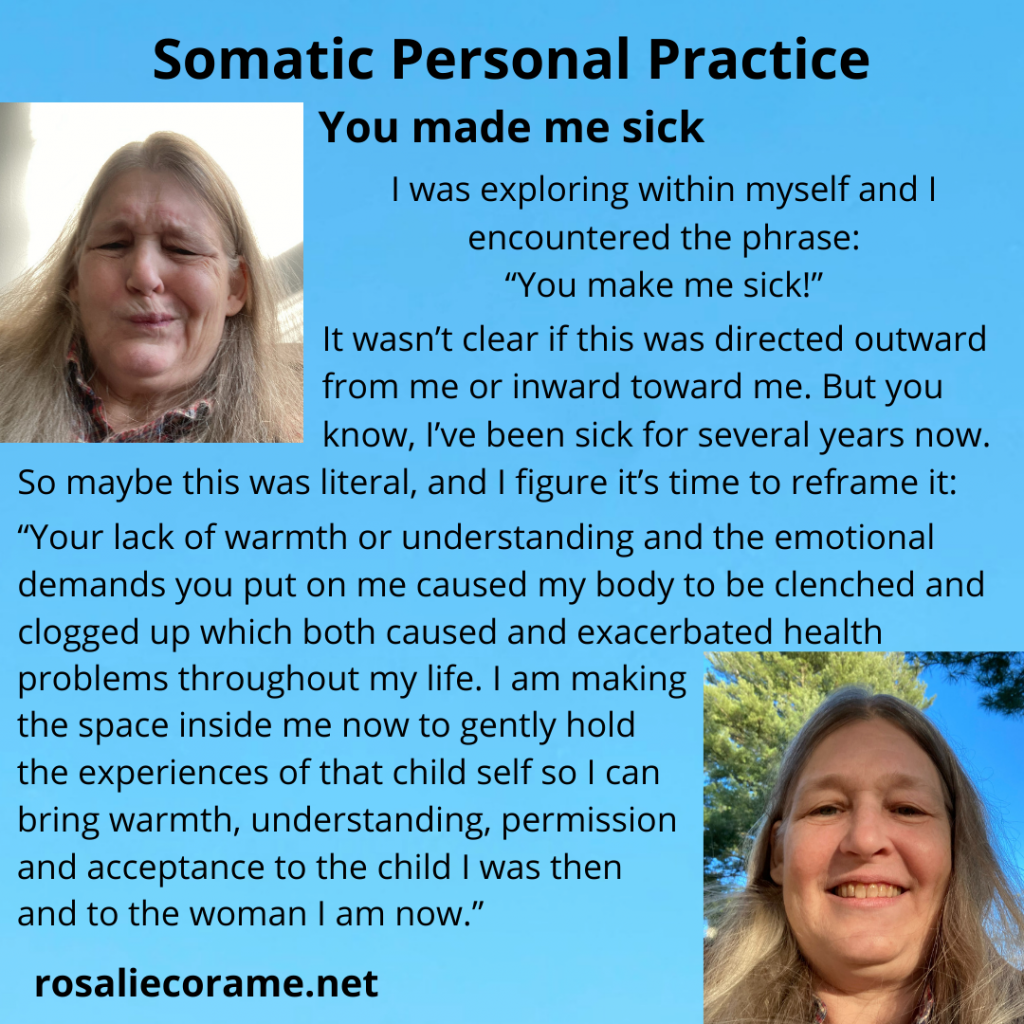
You made me sick
I was exploring within myself and I encountered the phrase: “You make me sick!”
It wasn’t clear if this was directed outward from me or inward toward me. But you know, I’ve been sick for several years now.
So maybe this was literal, and I figure it’s time to reframe it:
“Your lack of warmth or understanding and the emotional demands you put on me caused my body to be clenched and clogged up which both caused and exacerbated health problems throughout my life. I am making the space inside me now to gently hold the experiences of that child self so I can bring warmth, understanding, permission and acceptance to the child I was then and to the woman I am now.”
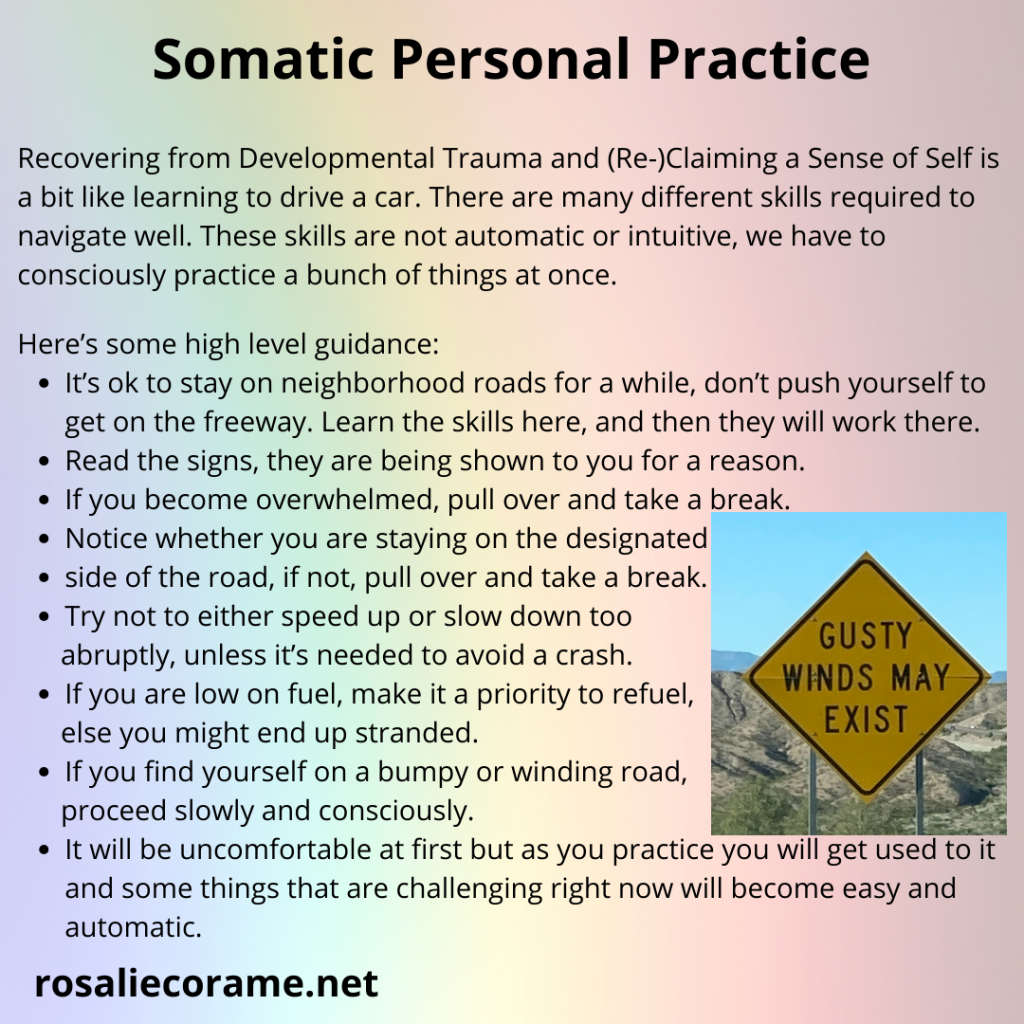
Recovering from Developmental Trauma and (Re-)Claiming a Sense of Self is a bit like learning to drive a car. There are many different skills required to navigate well. These skills are not automatic or intuitive, we have to consciously practice a bunch of things at once.
Here’s some high level guidance:
Hello, Beloved fellow humans, friends and travelers,
Let me start out by saying that I am taking new transformational somatic trauma coaching clients.
The people who may benefit from working with me are people whose inner experience has always been somewhat uncomfortable and chaotic and who are willing to be curious and explore what is happening in the layers of experience that occur beneath their conscious awareness. If this describes someone you know, you might direct them to my website or invite them to sign up for my newsletters.
Some things my clients report as a result of working with me:
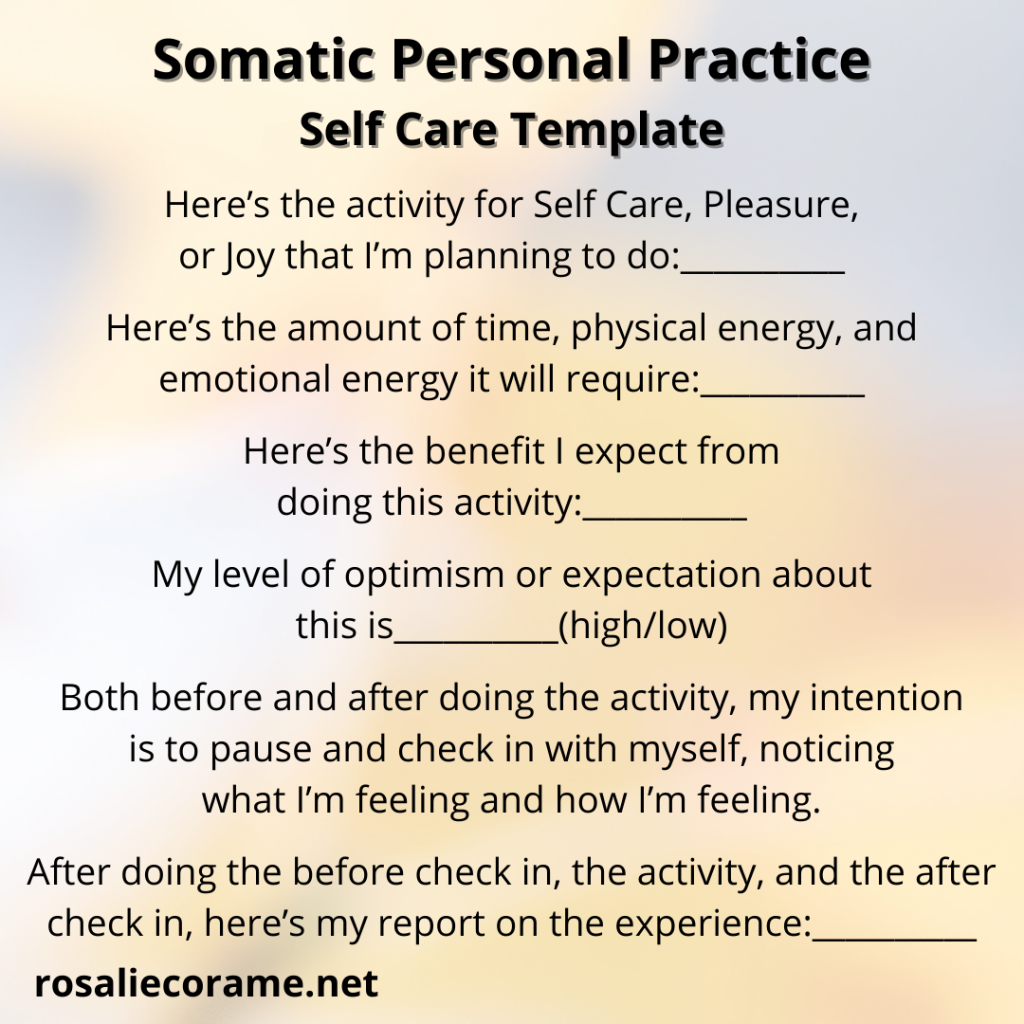
Somatic Personal Practice
Self Care Template
Here’s the activity for Self Care, Pleasure, or Joy that I’m planning to do:__________
Here’s the amount of time, physical energy, and emotional energy it will require:__________
Here’s the benefit I expect from doing this activity:__________
My level of optimism or expectation about this is__________(high/low)
Both before and after doing the activity, my intention is to pause and check in with myself, noticing what I’m feeling and how I’m feeling.
After doing the before check in, the activity, and the after check in, here’s my report on the experience:__________
Mine today: I’m planning to take a bath. I’m planning to intentionally slow down through the whole process including even walking down the stairs to the tub. I’m planning to try to notice the experience of my skin throughout, noticing the sensations, feeling the water and the air, stroking my own skin, really having an experience of my skin. And particularly noticing what feels good. Finding words for how it feels good.
This will take 15-20 minutes and not much energy.
The benefit I might get would be calming, grounding, coming more into my body, taking up more space in my body.
My optimism is medium. I might have a really satisfying and profound experience or it might fall flat and feel more cognitive than somatic or more confusing than pleasing.
I’m checking in now beforehand with what and how I’m feeling. Nothing hurts. I feel pretty neutral – I’m not really feeling dread but I’m not really feeling aliveness or eagerness either. When I feel deeper under the surface looking for emotions, the first thing I notice is this impulse to collapse, hide, be perfectly still, be invisible, and to not have to interact with anyone or do anything. Because I’ve noticed this, I would like to make some space for this part in the tub. Space to be and to palpably experience doing nothing. So that might change my strategy around attention to my skin. I think I can do both but not necessarily simultaneously.
Checking in after.
I’m feeling a bit tired. My breath is sort of panting. I feel more connected, or more something. Not neutral like before. There’s a warmth through my body, especially my back and my upper chest.
There’s a softening. I can feel gravity. And I just took a spontaneous deep breath. There’s something like peace, gratitude, and heaviness all mixed in together.
So, how did it go? I repeatedly forgot to slow down, starting with going down the stairs, then I would remember, then I would forget.
I found that it was difficult or impossible to keep my focus on one thing, and I didn’t force myself to do that. In some moments, I intentionally paused with something, like noticing the touch of my fingers on the top of my head under the water. After a while, my thoughts went where they went and my body went where it went. For a few minutes my neck was slowly moving, stretching, being with or working on something. At one point I realized the air felt too warm. I pushed the tub door open with more and more force, but I couldn’t get it to open far enough to stay open until I sat up and leaned over to push the door wide open. Then there was cool air and hot water.
Even though my attention didn’t go where I was planning for it to go, I believe the intentionality helped me to be more aware of my body and what it feels and wants.
My breath is easy, my shoulders are down, and my emotional energy is relatively calm, not pushing or racing. This was a useful and pleasant practice.
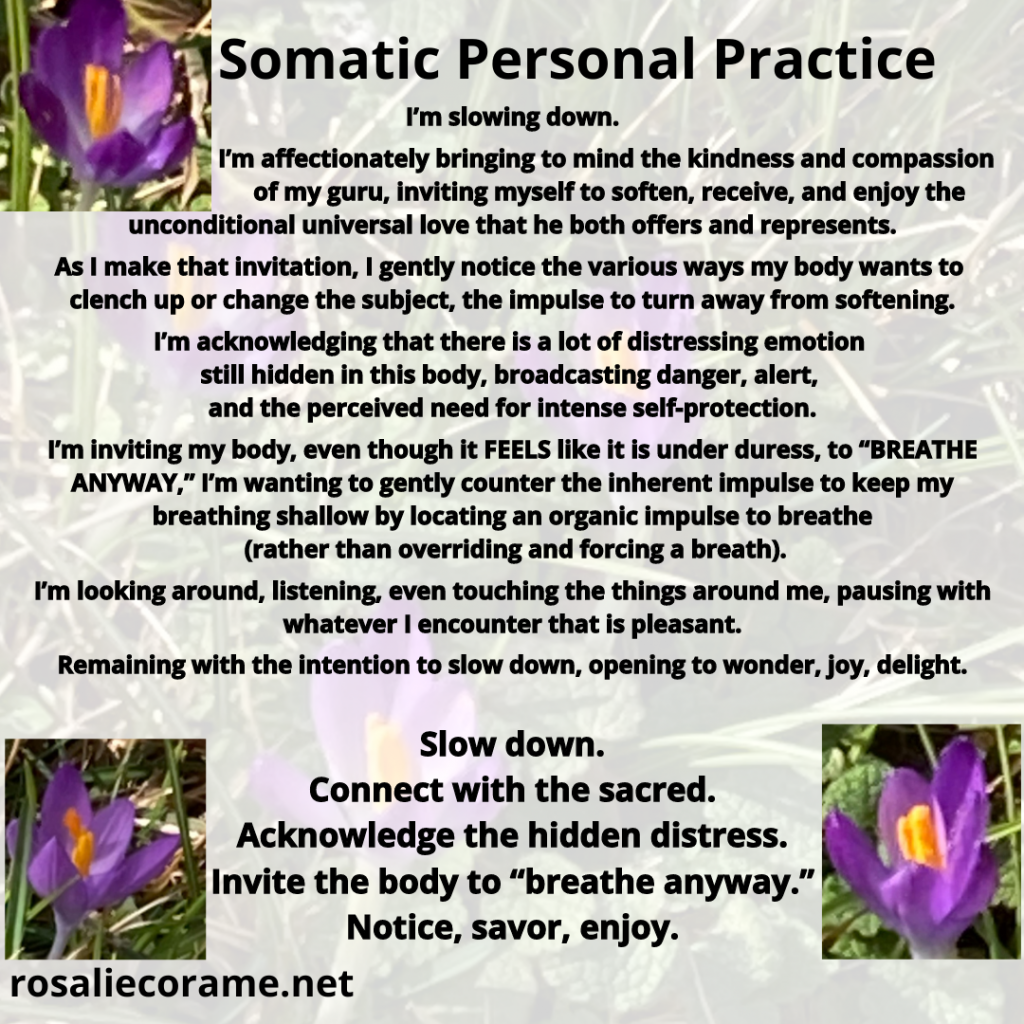
I’m slowing down.
I’m affectionately bringing to mind the kindness and compassion of my guru, inviting myself to soften, receive, and enjoy the unconditional universal love that he both offers and represents.
As I make that invitation, I gently notice the various ways my body wants to clench up or change the subject, the impulse to turn away from softening.
I’m acknowledging that there is a lot of distressing emotion still hidden in this body, broadcasting danger, alert, and the perceived need for intense self-protection.
I’m inviting my body, even though it FEELS like it is under duress, to “BREATHE ANYWAY,” I’m wanting to gently counter the inherent impulse to keep my breathing shallow by locating an organic impulse to breathe (rather than overriding and forcing a breath).
I’m looking around, listening, even touching the things around me, pausing with whatever I encounter that is pleasant.
Remaining with the intention to slow down, opening to wonder, joy, delight.
Slow down.
Connect with the sacred.
Acknowledge the hidden distress.
Invite the body to “breathe anyway.”
Notice, savor, enjoy.
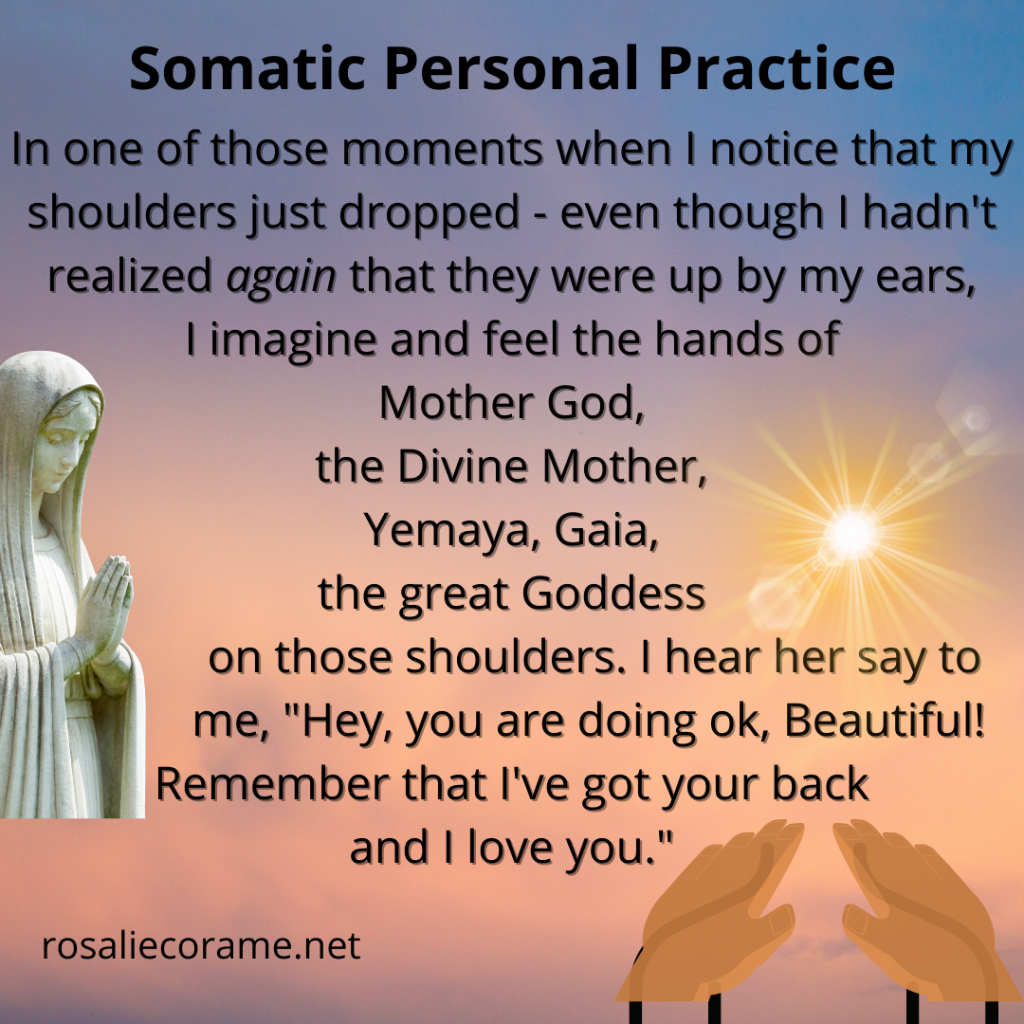
In one of those moments when I notice that my shoulders just dropped – even though I hadn’t realized again that they were up by my ears ,I imagine and feel the hands of Mother God, the Divine Mother, Yemaya, Gaia, the great Goddess on those shoulders. I hear her say to me, Hey, you are doing ok, Beautiful! Remember that I’ve got your back and I love you.”
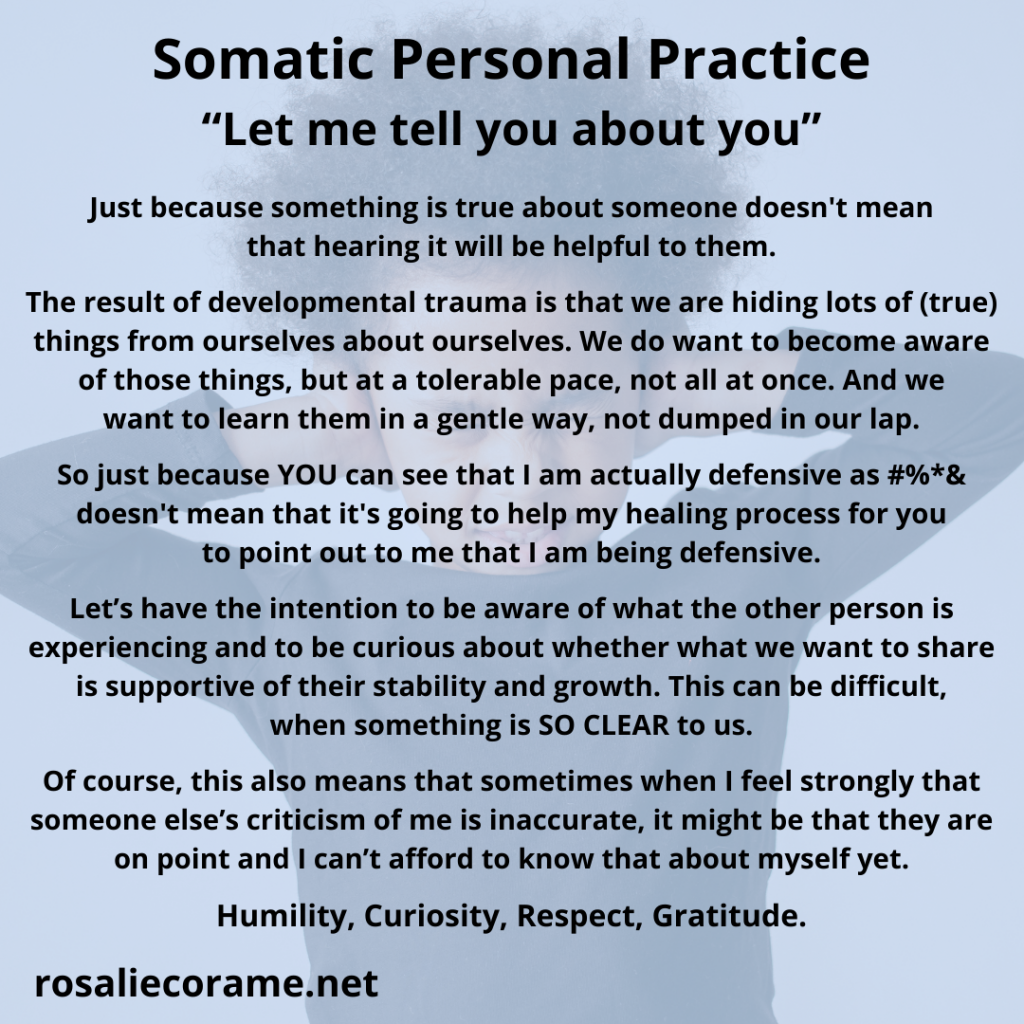
“Let me tell you about you”
Just because something is true about someone doesn’t mean that hearing it will be helpful to them.
The result of developmental trauma is that we are hiding lots of (true) things from ourselves about ourselves. We do want to become aware of those things, but at a tolerable pace, not all at once. And we want to learn them in a gentle way, not dumped in our lap.
So just because YOU can see that I am actually defensive as #%*& doesn’t mean that it’s going to help my healing process for you to point out to me that I am being defensive.
Let’s have the intention to be aware of what the other person is experiencing and to be curious about whether what we want to share is supportive of their stability and growth. This can be difficult, when something is SO CLEAR to us.
Of course, this also means that sometimes when I feel strongly that someone else’s criticism of me is inaccurate, it might be that they are on point and I can’t afford to know that about myself yet.
Humility, Curiosity, Respect, Gratitude.
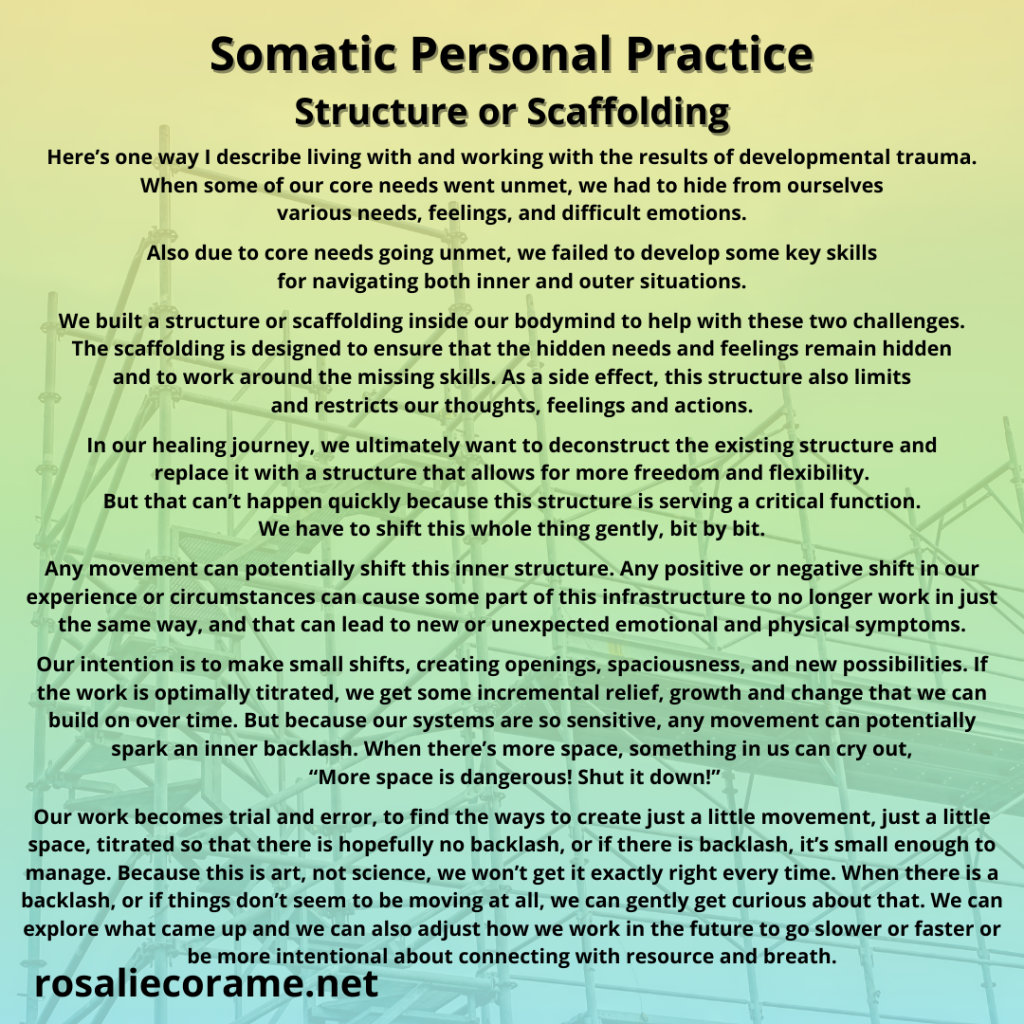
Here’s one way I describe living with and working with the results of developmental trauma.
When some of our core needs went unmet, we had to hide from ourselves various needs, feelings, and difficult emotions.
Also due to core needs going unmet, we failed to develop some key skills for navigating both inner and outer situations.
We built a structure or scaffolding inside our bodymind to help with these two challenges.
The scaffolding is designed to ensure that the hidden needs and feelings remain hidden and to work around the missing skills. As a side effect, this structure also limits and restricts our thoughts, feelings and actions.
In our healing journey, we ultimately want to deconstruct the existing structure and replace it with a structure that allows for more freedom and flexibility.
But that can’t happen quickly because this structure is serving a critical function.
We have to shift this whole thing gently, bit by bit.
Any movement can potentially shift this inner structure. Any positive or negative shift in our experience or circumstances can cause some part of this infrastructure to no longer work in just the same way, and that can lead to new or unexpected emotional and physical symptoms.
Our intention is to make small shifts, creating openings, spaciousness, and new possibilities. If the work is optimally titrated, we get some incremental relief, growth and change that we can build on over time. But because our systems are so sensitive, any movement can potentially spark an inner backlash. When there’s more space, something in us can cry out, “More space is dangerous! Shut it down!”
Our work becomes trial and error, to find the ways to create just a little movement, just a little space, titrated so that there is hopefully no backlash, or if there is backlash, it’s small enough to manage. Because this is art, not science, we won’t get it exactly right every time. When there is a backlash, or if things don’t seem to be moving at all, we can gently get curious about that. We can explore what came up and we can also adjust how we work in the future to go slower or faster or be more intentional about connecting with resource and breath.